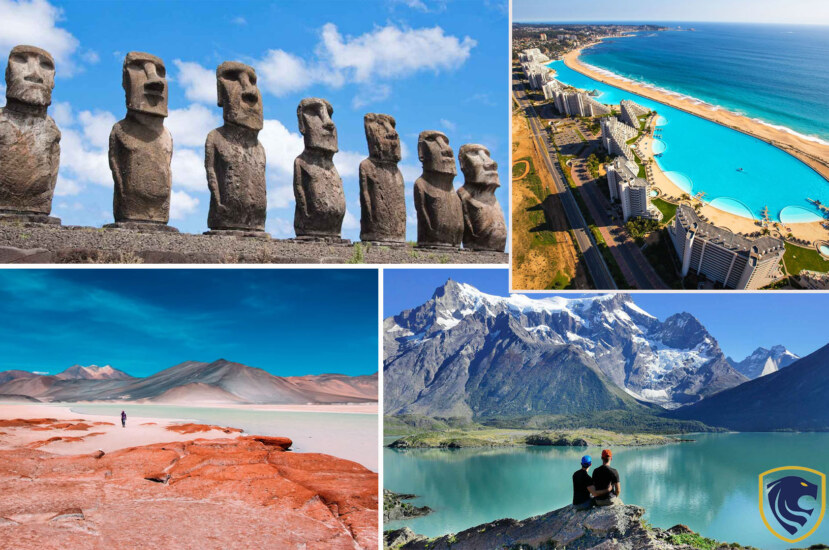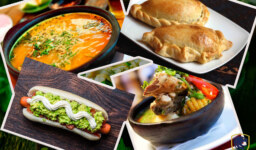Learn more about Chile, a country where culture, people, country, and history come together to form a fascinating tapestry. Chile, which is sandwiched between the Andes Mountains and the Pacific Ocean, has a rich history woven from native customs, Spanish colonial influence, and contemporary innovation. Visitors are greeted with wide arms by Chile’s wonderful hospitality, forging sincere bonds. Easter Island’s secrets and the echoes of Mapuche ceremonies coexist here with the rhythms of vibrant folk music and ancient dances. Moreover, the air is permeated by the perfume of Chilean food, which is bursting with a variety of tastes and spices. Chile reveals a unique story of resiliency and cultural blending through humming marketplaces, vibrant festivals, and age-old customs. So, Join us on a journey to unravel the intriguing factors that define Chile’s cultural mosaic, reflecting the nation’s past, present, and the promise of a vibrant future.
Cultural Fusion
Chile’s rich cultural variety and fusion are presented in intriguing fashion. Traditional Mapuche culture seamlessly combines with Spanish colonial history to create a distinctive identity. Bright folk music and dances like cueca reflect this mix and the centuries-long blending of several cultures. This blending of native ingredients and European influences results in flavorful treats in Chile’s culinary landscape. In spite of modernity, the Mapuche language, Mapudungun, contributes linguistic diversity.

Cultural Fusion
Furthermore, famous artists like Violeta Parra and Gabriela Mistral have an international impact on art, exhibiting Chilean ingenuity. Spanish-inspired religious rituals feature vibrant processions and ardent celebrations.
Chile’s cultural fusion pervades daily life and influences social standards, gastronomy, and art. This synthesis, which embraces variety and defines the nation’s attitude, is more than just a historical artifact. Also, the endurance of its people and the depth of its legacy are demonstrated by Chile’s capacity to embrace its cultural variety, making it an alluring topic for investigation.
Warm Hospitality
Travelers are welcomed into Chile by the country’s well-known warm hospitality. Visitors frequently find themselves greeted upon arrival with sincere grins and open hearts. This friendliness is not simply a formality. It also permeates Chilean society and makes relationships special. Locals are eager to introduce tourists to traditional foods and flavors at restaurants, sharing not just meals but also the history of the local cuisine. Even strangers are helpful and willing to give instructions, displaying a strong sense of community.

Warm Hospitality
Chilean houses ooze friendliness. For instance, visitors are welcomed with open arms and frequently treated to handmade treats and beverages. Every tourist is treated with the same warmth and consideration, whether they are in crowded metropolis or far-off villages. This welcoming attitude extends to regional customs and holidays. Participation in cultural activities is frequently encouraged, which heightens a sense of belonging. The friendliness of Chileans rubs off on those who encounter it, creating a lasting impression. So, this genuinely kind hospitality makes a journey to Chile into a pleasant cultural interchange, enhancing the travel adventure and forging enduring memories.
Mapuche Heritage
The Mapuche legacy, an indigenous minority conserving ancient customs among modernity, is a stunning addition to Chile’s cultural tapestry. The Mapuche, sometimes known as the “People of the Land,” have had a significant impact on Chilean culture by introducing their spirituality, Mapudungun, and language.
The traditions and rituals of the Mapuche people, which have their roots in a relationship with nature, depict peaceful cooperation. Moreover, the delicate silverwork and vivid fabrics of the Mapuche people are revered for their artistry and symbolism, which frequently features images of the natural world and ancestral spirits. Also, with a focus on corn and potatoes, Mapuche food exemplifies their close connection to the ground. Popular Mapuche foods include locro, a hearty stew, and catutos, a sort of bread.

Mapuche Heritage
The perseverance of the Mapuche is reflected in their fight for cultural and land rights, making their legacy an essential part of Chilean identity. The Mapuche tradition offers a remarkable window into Chile’s rich cultural past. It is combined with its exquisite art, profound spirituality, and profound love for environment. So, in spite of the contemporary complexity of Chilean culture, learning about Mapuche customs provides a fascinating insight into a bygone era and serves as a constant reminder of this indigenous group’s resilient spirit.
Wine Culture
Chile’s rich history and excellent taste are reflected in its wine culture. The vineyards of Chile, which are tucked between the Pacific Ocean and the Andes Mountains, benefit from a variety of climates and excellent soils, producing wines of exceptional quality. Particularly, Cabernet Sauvignon and Carmenere, a grape varietal that was rediscovered in Chile, are two of the nation’s most well-known red wines. Visits to vineyards offer an insight into the painstaking winemaking process, where time-honored practices are combined with cutting-edge methods. Also, many vineyards are open to tourists, providing tastings among beautiful scenery and cultivating a strong respect for the craft of winemaking.

Wine Culture
Because Chile is committed to environmental awareness, many of its wineries use sustainable procedures. Popular wine locations that each produce unique varietals include the Maipo Valley, Colchagua Valley, and Casablanca Valley. Since the time of Spanish colonization, wine has been a feature of festivals and social events across Chile. Chileans take great satisfaction in sharing their wines, which are frequently combined with regional cuisine to improve dining experiences.
International praise for Chilean wines serves as a sign of the nation’s viticultural competence. Furthermore, the development of Chile’s wine culture parallels Chile’s own development, making it a vital component of the country’s identity and an intriguing subject for research.
Folklore and Traditions
Chile’s folklore and customs form a colorful tapestry that captures the essence of the country. The energetic cueca dance, backed by upbeat music, is a distinguishing feature of Chilean celebrations. Also, the country’s agricultural background is reflected in the equestrian tradition of rodeo, where talented riders display their abilities. Fiestas Patrias, a traditional event honoring Chile’s independence, is known for its delectable cuisine, vibrant parades, and folk dances. The intriguing stories of the Chilote culture of Chiloé Island are on display in the distinctive festivals and folklore performances.

Folklore and Traditions
Indigenous methods are preserved in Chilean crafts like the beautifully woven textiles and ceramics that have been handed down through the years. So, in order to pay homage to their ancestors, artists include Mapuche symbols into their works. Chilean food is closely entwined with tradition. So, beloved dishes like empanadas, pastel de choclo (corn pie), and curanto are frequently consumed during social events.
The country’s rich background is reflected in Chilean music, which ranges from the eerie melodies of the Mapuche kultrn to the upbeat strains of the charango. Chile’s folklore and customs reflect centuries of mingling of cultures and depict tales of resiliency and joy. Investigating these traditions offers engrossing insights into Chile’s character and fosters a profound respect for the country’s cultural diversity.
Preserved Indigenous Languages
A rich linguistic variety is being cared for by Chile, where a number of indigenous languages have survived the passage of time. The Mapuche people’s language, Mapudungun, has resonance in both traditional and modern situations, signifying their enduring cultural strength. Easter Island’s indigenous Rapa Nui language preserves the Polynesian legacy of the island by transmitting its ancient wisdom and traditions.

Preserved Indigenous Languages
The fact that these languages are being preserved shows Chile’s dedication to its indigenous heritage. Moreover, bilingual education programs have been developed as a result of the efforts of local communities, educators, and the government, ensuring that these languages are passed on to future generations. These languages convey more than just words. They also embody various worldviews, mythologies, and religious convictions. As carriers of historical tales and symbols of cultural identity, they act as containers for history.
The survival of indigenous languages in Chile serves as a reminder of how crucial it is to celebrate linguistic variety, honor the contributions of the past, and provide future generations a sense of identity in today’s globally interconnected world. The commitment of Chile to preserving these languages not only enhances its cultural history. But also adds to the worldwide heritage of indigenous peoples.


